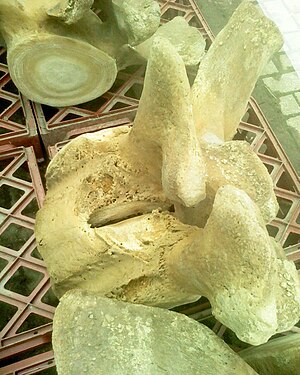Ankylosis
| Ankylosis | |
|---|---|
 |
|
| Osseous ankylosis has fused two vertebrae of this North Atlantic right whale specimen | |
| Classification and external resources | |
| Specialty | rheumatology |
| ICD-10 | M24.6 |
| ICD-9-CM | 718.5 |
| DiseasesDB | 29910 |
| MeSH | D000844 |
Ankylosis or anchylosis (from Greek ἀγκύλος, bent, crooked) is a stiffness of a joint due to abnormal adhesion and rigidity of the bones of the joint, which may be the result of injury or disease. The rigidity may be complete or partial and may be due to inflammation of the tendinous or muscular structures outside the joint or of the tissues of the joint itself.
When the structures outside the joint are affected, the term "false ankylosis" has been used in contradistinction to "true ankylosis", in which the disease is within the joint. When inflammation has caused the joint-ends of the bones to be fused together, the ankylosis is termed osseous or complete and is an instance of synostosis. Excision of a completely ankylosed shoulder or elbow may restore free mobility and usefulness to the limb. "Ankylosis" is also used as an anatomical term, bones being said to ankylose (or anchylose) when, from being originally distinct, they coalesce, or become so joined together that no motion can take place between them.
Evidence for ankylosis found in the fossil record is studied by paleopathologists, specialists in ancient disease and injury. Ankylosis has been reported in dinosaur fossils from several species, including Allosaurus fragilis, Becklespinax altispinax, Poekilopleuron bucklandii, and Tyrannosaurus rex (including the Stan specimen).
![]() This article incorporates text from a publication now in the public domain: Chisholm, Hugh, ed. (1911). "". Encyclopædia Britannica (11th ed.). Cambridge University Press.
This article incorporates text from a publication now in the public domain: Chisholm, Hugh, ed. (1911). "". Encyclopædia Britannica (11th ed.). Cambridge University Press.
...
Wikipedia
